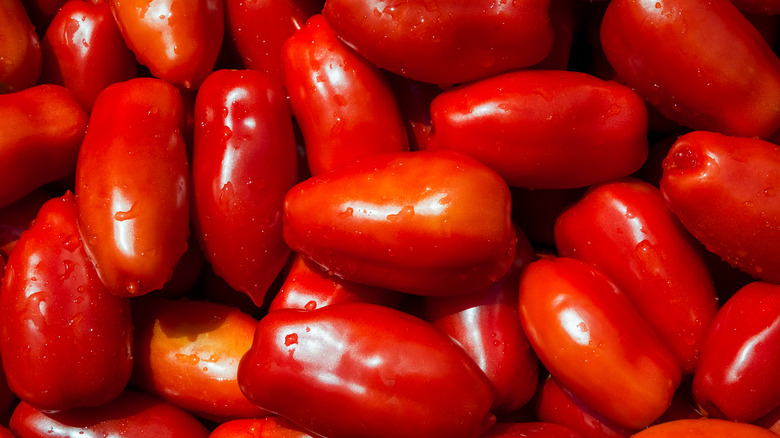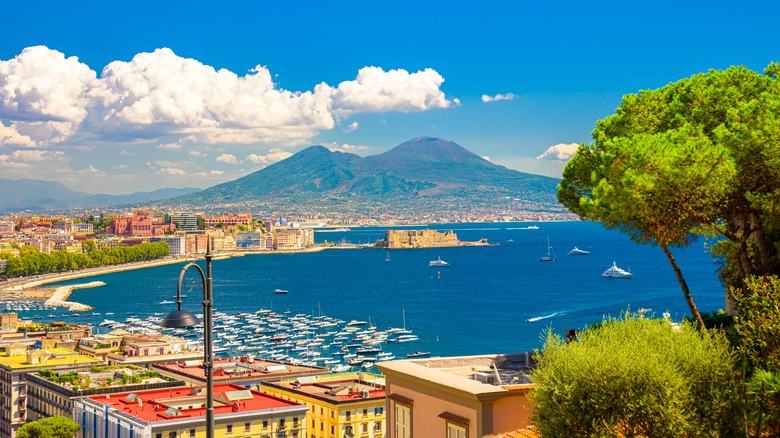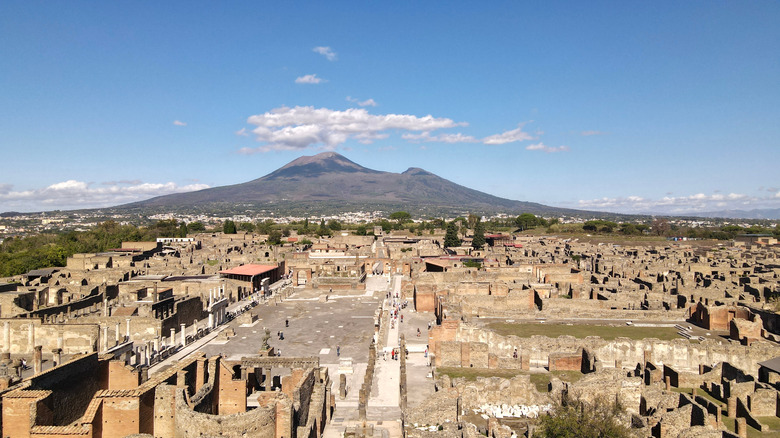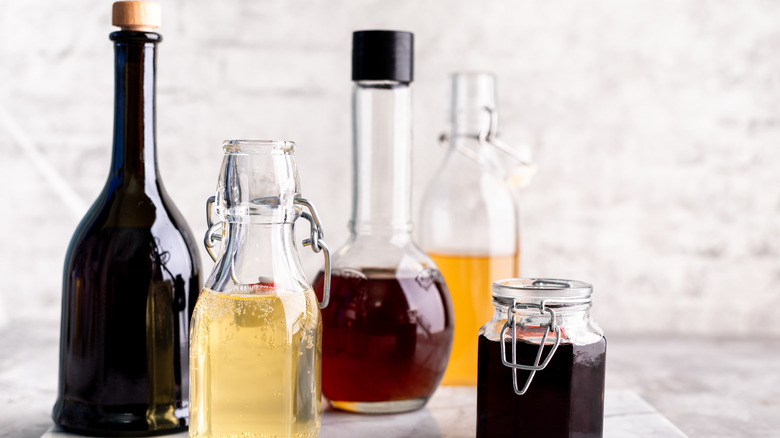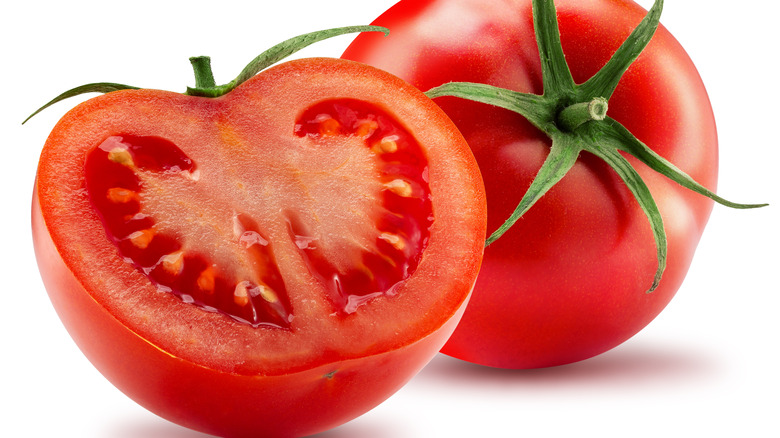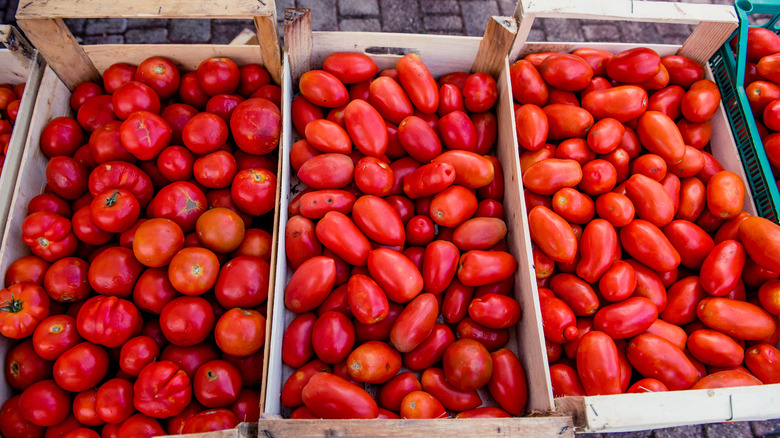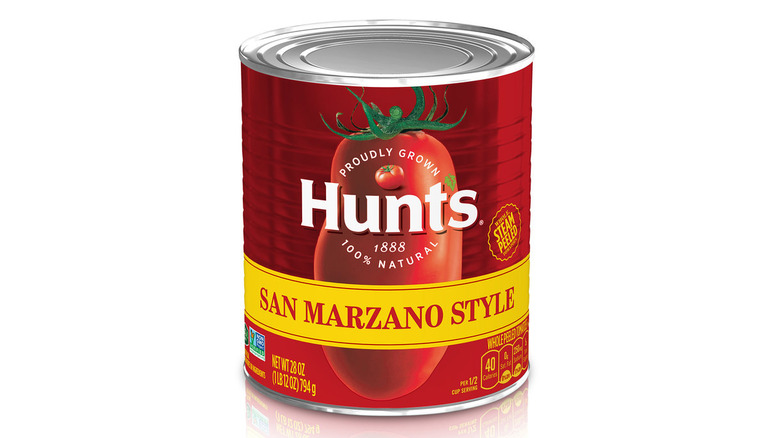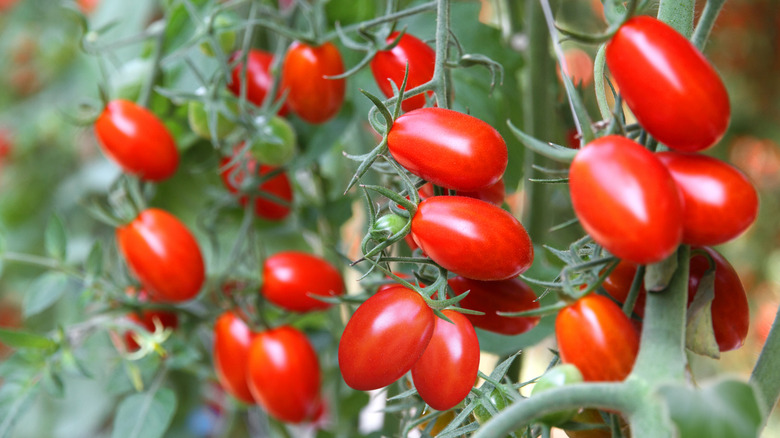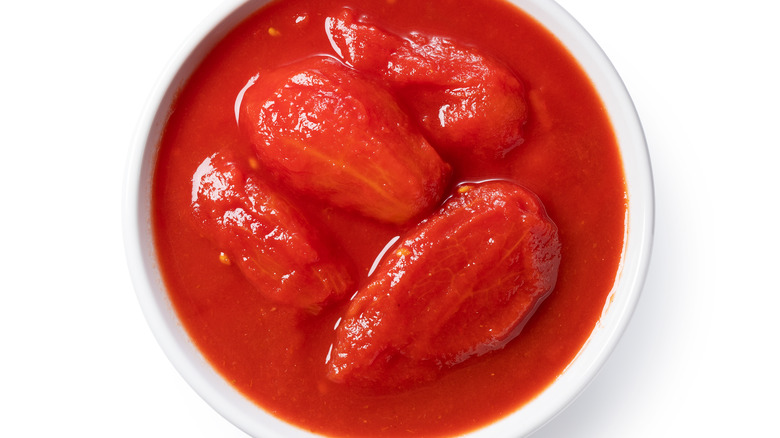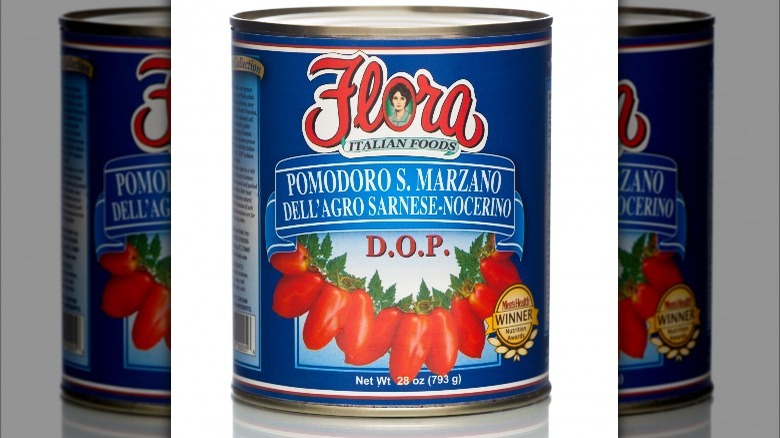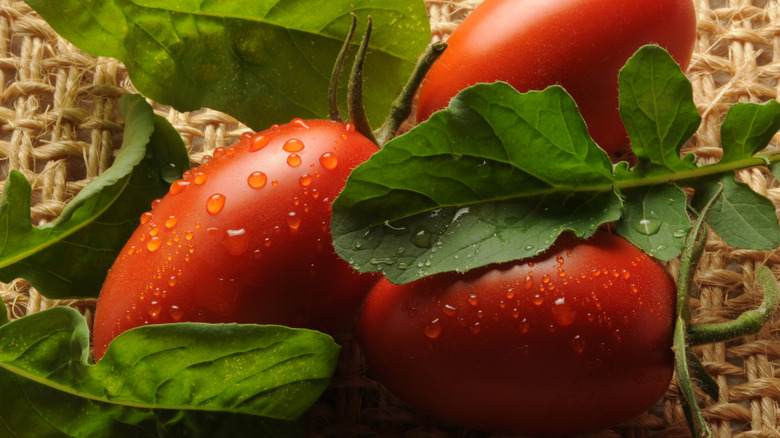The Untold Truth Of San Marzano Tomatoes
San Marzano tomatoes are a deluxe variety native to Southern Italy. Since conquering the world and spreading their fame far beyond Italy, these tomatoes have become synonymous with thoughtful, gourmet cooking. They have proven so popular that the most widely-distributed plum tomato — the Roma — is actually a descendant of this aristocratic variety.
However, most food lovers are familiar with the canned preserved version, which allows devotees of Italian food the world over to appreciate these flavorful, sun-drenched specialties. The name found on the can refers to both the type of tomato, as well as the region in Italy where they are — by law — required to be produced. However, there is more than meets the eye here, and navigating the labels of various products that bill themselves as authentic San Marzanos can be intentionally complicated.
Read on to follow all the twists and turns that this unsuspecting Italian product provides for unwary consumers.
The name is protected by law
Food traditions are taken very seriously in Europe. If a certain regional specialty is popular enough, a specific way to make it can become enshrined in law. Most countries have systems of governance over who has the right to refer to their product names. A prime example is wine, as experts agree that the geographic location influences the finished product (per WSET).
In Italy, this takes the form of the Denominazione d'Origine Protetta (D.O.P.), which indicates a product with a protected designation of origin (via European Commission). This is a cornerstone for Italian patrimony and a way for native traditions in various regions to be declared in an official capacity. Parmigiano-Reggiano is a popular example, and of course, San Marzano tomatoes are another noteworthy product.
San Marzano refers to the region in Southern Italy where the tomatoes are grown, as well as to the specific tomato variety (per Serious Eats.) This means that you can technically have San Marzanos that qualify for the name but not for the official government designation if they are not grown in the correct region. The standard for these tomatoes is intentionally set very high and specifies that they must be grown in the right place and harvested at a certain size. These restrictions are imposed to prevent inferior products from being labeled with the famous name.
San Marzano tomatoes come from the area between Naples and Salerno
The region of San Marzano is located in Southern Italy, an area that is hotter and more arid than the North of the country. It turns out these are the perfect growing conditions for tomatoes, as they can't thrive in the North's gentler, more temperate climate. This explains why tomatoes and red sauce are synonymous with Italian food for many Americans: The vast majority of Italian immigrants were escaping poor conditions in the South when they crossed the Atlantic (per PBS).
As Martha Stewart explains, the tomatoes come from a little sliver of land between the cities of Naples and Salerno. Naples, known for its world-famous pizza, is one of the biggest cities in Italy even if it's not well-regarded as a tourist destination (per Business Insider). Salerno, meanwhile, is known for the quality of its citrus fruits, and the nearby Amalfi coast has been famous for its lemons for centuries, according to Delicious Italy.
Although the region lacks in infrastructure and investment compared to its Northern neighbors, there is no lack of sophisticated — and delicious — culinary traditions emblematic of what makes Italian food so good: simple high-quality products, treated in just the right way to bring out their best qualities.
It is one of the only varieties of tomato that can be used in a true Neapolitan pizza
Naples is a very old city, and many of its traditions — and those of the surrounding region — go back centuries, if not millennia. However, pizza is more of a novelty, and one story suggests that in the late 1800s, Queen Margherita was served a dish of flatbread topped with tomatoes, mozzarella cheese, and basil, per Britannica. The combination of colors resembled the tricolor flag of Italy, and a beloved tradition was born.
Tomatoes are native to South America and were discovered by European explorers when they made the trip over (per Smithsonian). When tomatoes were first brought back to Europe, they were thought to be poisonous due to their close relation to the deadly nightshade plant. This kept people from realizing the potential of the tomato for centuries. However, once people discovered that it wasn't poisonous but actually quite tasty, it became inseparable from certain national cuisines: It would be hard to picture Italian food without the tomato.
In pursuit of safeguarding what makes Neapolitan pizza so special, the Italian government has issued guidelines that cooks must follow. One of these is that only San Marzano variety tomatoes can be used in the sauce (per BBC). This use of local, regional specialties is living proof of the foodie's adage: "If it grows together, it goes together."
Many are growing around Mt Vesuvius
Pompeii, a prosperous thriving town that was wiped out in 79 AD by the active volcano Mount Vesuvius, is one of the most well-preserved examples of classical Roman daily life, Pompeii Online explains. The fact that it was buried under ash and lava prevented further decomposition and had a number of other impacts.
According to a 2021 study published in the journal Soil Security, volcanic ash has many benefits to offer growing crops. Not only is it rich in nutrients that are depleted in soil from regular use, but it is in fact a carbon sink that can actively pull carbon from the air. Although it can be synthetically reproduced, the best — and most sustainable — sources are actual volcanoes.
The local people living around Mount Vesuvius recognize this potential and they grow their precious, government-regulated tomatoes on its slopes. As Food52 explains, the volcanic soil makes for a sweeter and less acidic tomato, qualities that make them especially nice for cooking. Atlas Obscura explains that the soil, rich in phosphorus and potassium, enhances these tomatoes by coaxing out a depth of flavor that most other varieties struggle to achieve.
They are lower in acid than other tomatoes
As the venerable culinary school Le Cordon Bleu explains, good cooking comes down to balance. Specifically, it entails weighing all of the fundamental tastes against each other: salty, sweet, bitter, sour, and umami. This means that altering one ingredient — or mistreating it — can throw off an entire dish. In seeking a balance between flavors, cooks must often choose one ingredient over another option.
San Marzano tomatoes happen to be a tomato variety with a lower acidity — or sourness — than most. This is a benefit since a tomato sauce that is too sharp will require a lot of sugar to create balance (a practice that Epicurious explains is already controversial among some chefs). A low-acid tomato like San Marzano is also better for people who suffer from acid reflux or heartburn, which can be aggravated by highly acidic food.
This tomato's minimally sour profile means that its sweet, natural flavors are able to shine through. It is a fruit, after all, even if the U.S. Supreme Court does not agree (per The Washington Post).
Cooks will love the fact that they have fewer seeds
Anyone who has cooked a batch of tomato sauce can attest that dealing with the plentiful seeds packed into each tomato can be a nuisance. Although the seeds are perfectly edible as Prepared Cooks explains, they can ruin the texture of a finished product, as well as trigger acid reflux in those prone to it. Italians are partial to buying tomato passata, which literally means strained tomatoes and is exactly what it sounds like: uncooked, strained tomato puree (per Kitchn). This eliminates the skin and the seeds, removing any distracting textures.
While there are plenty of tips for peeling tomatoes and getting rid of the seeds, a better option is to pick a variety that is already low in seed content. San Marzano's tendency to produce fruit that is mostly flesh with relatively few seeds is one of the features that has endeared it to so many cooks (via Gardening Channel).
The liquid surrounding the seeds can water down a pot of sauce or a stew (although Cooks Illustrated claims it's the most flavorful part). Therefore, when you're dealing with a tomato that has a higher proportion of flesh versus seeds, you'll be able to cook it for less time which means it will maintain a fresher flavor.
You'll need to spend a bit more money
Considering that a can of San Marzano tomatoes can cost several times more than a store brand option of the same size, it does bring up the question: Are they worth it? There's no obvious answer since one cook may be happy to spend the extra money on a product they know is a genuine, artisanally-produced heirloom item while another may be just as happy to go with whatever's on sale.
Thanks to the rigorous process that must be adhered to in order to net the Italian government's thumbs up — conveyed via the coveted D.O.P. label on the can — growers must recoup this investment and they inevitably pass that higher cost on to the consumer. There may be little more than smoke and mirrors to the higher price tag, however. Food & Wine details a phenomenon where people rate a wine higher when they know that it's particularly expensive. It could be that the same trick holds true with San Marzano tomatoes, and any perceived increase in quality is all in the buyer's mind.
The vast array of celebrity chefs who enthusiastically tout the benefits of these Italian tomatoes seems to contradict that cynical take, but at the end of the day, it's up to each consumer to consider if it's worth it to them. Just so long as the tomatoes aren't fake. But more on that later.
You can get domestically-produced versions too
Since San Marzano refers to the tomato variety and the region it comes from, it is possible to find tomatoes that can legitimately claim to be San Marzano without being Italian or labeled as D.O.P. In fact, many American brands have released their own versions of these pricey tomatoes, which usually get labeled as "San Marzano style" (via PR Newswire).
One obvious clue to determine if they are genuine D.O.P. is whether they are canned as whole tomatoes. Per Wide Open Eats, diced or crushed varieties cannot be the original Italian product and must necessarily be produced somewhere outside of the San Marzano D.O.P. Imitations aren't necessarily bad products but they're certainly not the pride of Mount Vesuvius they are marketing themselves to be.
Americans love to copy global food traditions, and the results are sometimes less than flattering. However, as long as the tomatoes in the can are good, there is no reason to turn your nose up at a domestically-made product made in the San Marzano style.
You can grow your own
One of the best ways to ensure access to the real deal is to grow your own tomatoes, and many seed catalogs sell the means to sprout San Marzanos. This is ideal for any ambitious gardener who wants to try their green thumb at growing the Cadillac of tomatoes.
Since it can be hard to start a plant from seed in amateur conditions, Home for the Harvest recommends buying baby plants from a nursery and transplanting them to a sunny, well-watered spot when they're ready. Indeed, The Spruce reports that San Marzanos — like all tomato plants — prefer lots of direct sunlight. The outlet recommends up to eight hours of uninterrupted sunshine, so it's no wonder they hail from the sunny South of Italy.
The watering regimen is particularly important since tomato plants suffer when soil moisture drops below a certain level. If the plant starts to wilt, it becomes much more susceptible to the dreaded blossom end rot (via Savvy Gardening). This unsightly blemish will ruin your tomato harvest, so be sure to keep the soil moist if you plan on experimenting.
While it may be impossible to replicate the exact conditions of the volcanic soil of Mount Vesuvius where the originals are grown, you can still take steps — such as including wood ash in the potting soil — to replicate the nutritious, fortified soil of Southern Italy.
Many cooks prefer canned tomatoes to fresh ones
As Bon Appétit explains, although it may seem counterintuitive, many cooks prefer to use canned tomatoes over fresh ones. For one, the tomato season in the U.S. is relatively short — only about three to four months — which means that high-quality fresh tomatoes are unavailable for most of the year. This makes canned options a reliable choice for the time outside of peak tomato season.
As well, there are some difficulties that come with shipping fresh tomatoes. As NPR reports, most tomatoes sold in American grocery stores are picked when they are severely underripe. This is because a ripe tomato is a juicy, fragile disaster waiting to happen. Instead of shipping delicate ripe tomatoes all over the world, most growers pick hard fruit. Once the tomatoes arrive at their destination, ethylene gas is typically applied, causing them to soften and turn red.
While it may save tomato growers the headache of figuring out how to ship their crops, it leaves supermarket shoppers without many flavorful options ... except those that come in cans. Since the can is sturdy and the products within are picked at the peak of freshness, canned tomatoes are at the ideal ripeness level. In Italy, it's only a matter of hours between harvest and canning, according to Fav Family Recipes, which makes all the difference.
Italian brands don't contain calcium chloride
Italy takes its food culture very seriously with strict regulations about what is allowed to be served to the public. The New York Times details many differences in food safety laws between the U.S. and Europe. The biggest takeaway is that Europeans are much less tolerant of chemical food additives than Americans. The American Food and Drug Administration relies on companies to police their own additives, an approach that doesn't fly in Europe.
One noteworthy additive is calcium chloride, which the FDA labels GRAS (Generally Recognized as Safe), noting that it helps prevent browning in processed fruits and vegetables. The additive is incorporated into canned goods — including tomatoes — so that they arrive in your kitchen intact. Diced tomatoes are almost always treated with calcium chloride so that you don't end up with a can of tomato puree instead of distinct chunks (via Kitchn).
In Italy, producers do not use this additive and instead keep it natural, Kitchn explains. This means the tomatoes arrive soft and ready to break down further which is exactly what you want if you are making a sauce. Nonetheless, the consistency is worth keeping in mind when you are buying these premium tomatoes for a recipe.
Fraudulent versions exist
Unfortunately, as with many nice products, unscrupulous people have tainted San Marzano tomatoes. Just listen to Alton Brown, who explains that if you're not careful, you could end up buying a standard tomato at a premium price. Indeed, Food &Wine reports that 95% of tomatoes labeled as San Marzano in American stores are not authentic. This is because the American government does not regulate the use of the Italian D.O.P. label the way it does the U.S. Department of Agriculture's Certified Organic label.
To be absolutely certain that you are getting genuine San Marzanos, you should both check for a D.O.P. label from the Italian government and look for an official certification number on the bottom of the can. Another surefire way to spot a fake is to make sure the tomatoes are whole — any diced or pureed products cannot be called San Marzanos by Italian law (via Food & Wine).
Taste illustrates that many product reviews, such as by Epicurious and Cook's Illustrated, show that Americans consistently pick domestic tomatoes over pricier San Marzanos. However, this could be chalked up to the lack of availability of the real deal and, perhaps, a deliberate counterfeit sneaking its way into the taste tests.
When paying a premium price, it just makes sense to be absolutely certain that you're getting the genuine article and not the work of a fraudster.
